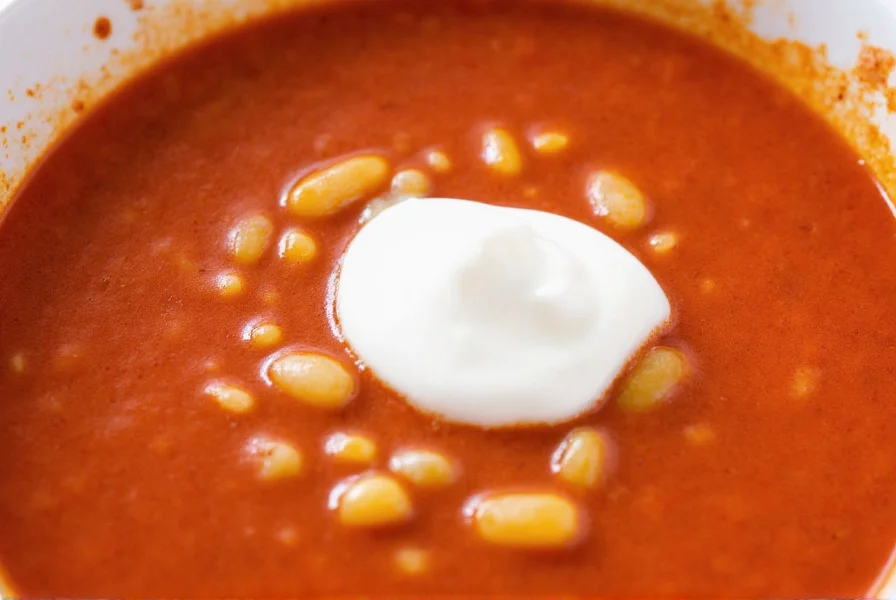When your chili turns out hotter than expected, knowing how to make chili less spicy can save your meal. The burning sensation comes from capsaicin, the compound in chili peppers that triggers heat receptors. This oil-soluble compound doesn't mix with water but binds well with fats, acids, and sugars—explaining why certain remedies work better than others.
Why Chili Gets Too Spicy: The Science Behind the Heat
Capsaicin concentration varies dramatically between pepper varieties. A single habanero contains up to 350,000 Scoville units, while a jalapeño ranges from 2,500-8,000. Mistakes happen when cooks:
- Underestimate pepper heat (especially when using dried vs fresh)
- Fail to remove seeds and membranes (where 80% of capsaicin resides)
- Add multiple spicy ingredients without balancing flavors
| Common Chili Peppers | Scoville Heat Units | Relative Heat Level |
|---|---|---|
| Bell Pepper | 0 SHU | Mild |
| Jalapeño | 2,500-8,000 SHU | Moderate |
| Habanero | 100,000-350,000 SHU | Very Hot |
| Ghost Pepper | 855,000-1,041,427 SHU | Extreme |
Immediate Fixes for Overly Spicy Chili
Dairy Solutions: The Capsaicin Neutralizer
Adding dairy remains the most effective method to make chili less spicy. Casein proteins in milk, yogurt, or sour cream bind to capsaicin molecules, literally washing them away from pain receptors. For best results:
- Stir in 1/4 cup whole milk or heavy cream per serving
- Top with sour cream or Greek yogurt just before serving
- Use full-fat dairy for maximum fat content to dissolve capsaicin
Pro tip: Avoid boiling dairy directly in chili to prevent curdling—add it at the end of cooking.

Acidic Counterbalances: pH Power
Acids help neutralize the alkaline nature of capsaicin. Adding citrus or vinegar creates chemical balance without diluting flavor:
- Lime juice: 1-2 tablespoons per quart of chili
- Vinegar: 1 teaspoon apple cider vinegar per serving
- Tomato paste: 2 tablespoons to add acidity and bulk
Acid works particularly well with tomato-based chili recipes, enhancing existing flavors while reducing perceived heat.
Sweetness to Counteract Heat
Sugar molecules compete with capsaicin for receptor sites. Natural sweeteners provide balance without artificial taste:
- Honey: 1 teaspoon per quart (adds floral notes)
- Brown sugar: 1 tablespoon per quart (complements smoky flavors)
- Maple syrup: 2 teaspoons per quart (works with bean-based chili)
Always add sweeteners gradually, tasting after each addition. Over-sweetening creates new flavor imbalances.
Dilution Methods: Bulk and Starch
When you need to make chili less spicy without altering flavor profile significantly:
- Add 1 cup cooked beans or corn per quart of chili
- Incorporate 1/2 cup unsweetened cocoa powder for depth
- Mix in 1/4 cup peanut butter for nutty richness (authentic in some regional recipes)
- Add vegetable broth to increase volume without changing texture
Dilution works best when you have time to let flavors meld—simmer for 15-20 minutes after adding ingredients.

Preventive Measures for Next Time
Professional cooks recommend these techniques to avoid overly spicy chili:
- Seed and membrane removal: Use a grapefruit spoon to scrape out white ribs and seeds where capsaicin concentrates
- Gradual addition: Add peppers in stages, waiting 10 minutes between additions to assess heat level
- Acid balancing: Include lime juice or vinegar early in cooking to create natural heat buffer
- Taste testing protocol: Use a spoon, not your finger, to avoid transferring capsaicin to sensitive areas
What NOT to Do: Common Mistakes
Avoid these ineffective approaches when trying to make chili less spicy:
- Adding water: Capsaicin isn't water-soluble, so this just dilutes flavor without reducing heat
- Adding more spice: "Balancing" with cayenne or hot sauce compounds the problem
- Using alcohol: While ethanol dissolves capsaicin, cooking off the alcohol leaves concentrated heat
- Over-relying on starch: Too much corn or rice makes chili mushy without addressing the root cause
Advanced Techniques for Serious Heat
When standard methods fail with extremely spicy chili:
- Create a rescue roux: Melt 2 tablespoons butter, stir in 2 tablespoons flour, then gradually whisk in milk until thickened. Add to chili to neutralize heat.
- Infuse with aromatic vegetables: Sauté onions, carrots, and celery in oil until caramelized, then blend into chili for flavor complexity that masks heat.
- Use fat extraction: Simmer chili with a few tablespoons of vegetable oil, then chill overnight. The solidified fat layer on top contains concentrated capsaicin that can be removed.











 浙公网安备
33010002000092号
浙公网安备
33010002000092号 浙B2-20120091-4
浙B2-20120091-4